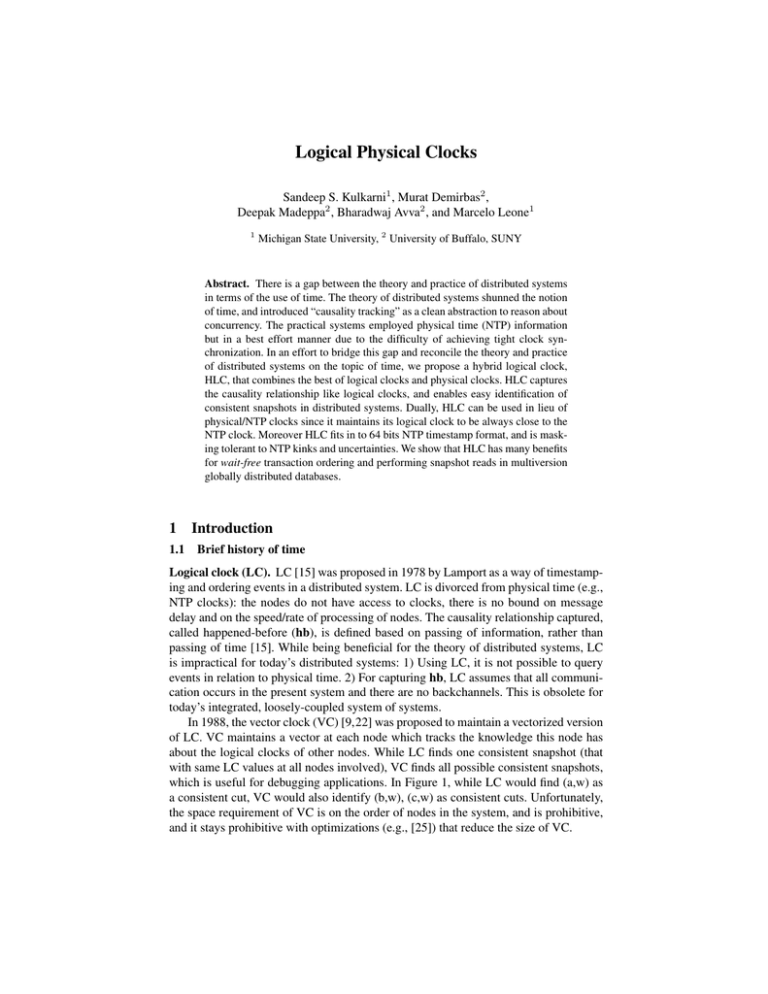Logical Physical Clocks Sandeep S. Kulkarni , Murat Demirbas ,
advertisement

Logical Physical Clocks
Sandeep S. Kulkarni1 , Murat Demirbas2 ,
Deepak Madeppa2 , Bharadwaj Avva2 , and Marcelo Leone1
1
Michigan State University, 2 University of Buffalo, SUNY
Abstract. There is a gap between the theory and practice of distributed systems
in terms of the use of time. The theory of distributed systems shunned the notion
of time, and introduced “causality tracking” as a clean abstraction to reason about
concurrency. The practical systems employed physical time (NTP) information
but in a best effort manner due to the difficulty of achieving tight clock synchronization. In an effort to bridge this gap and reconcile the theory and practice
of distributed systems on the topic of time, we propose a hybrid logical clock,
HLC, that combines the best of logical clocks and physical clocks. HLC captures
the causality relationship like logical clocks, and enables easy identification of
consistent snapshots in distributed systems. Dually, HLC can be used in lieu of
physical/NTP clocks since it maintains its logical clock to be always close to the
NTP clock. Moreover HLC fits in to 64 bits NTP timestamp format, and is masking tolerant to NTP kinks and uncertainties. We show that HLC has many benefits
for wait-free transaction ordering and performing snapshot reads in multiversion
globally distributed databases.
1
1.1
Introduction
Brief history of time
Logical clock (LC). LC [15] was proposed in 1978 by Lamport as a way of timestamping and ordering events in a distributed system. LC is divorced from physical time (e.g.,
NTP clocks): the nodes do not have access to clocks, there is no bound on message
delay and on the speed/rate of processing of nodes. The causality relationship captured,
called happened-before (hb), is defined based on passing of information, rather than
passing of time [15]. While being beneficial for the theory of distributed systems, LC
is impractical for today’s distributed systems: 1) Using LC, it is not possible to query
events in relation to physical time. 2) For capturing hb, LC assumes that all communication occurs in the present system and there are no backchannels. This is obsolete for
today’s integrated, loosely-coupled system of systems.
In 1988, the vector clock (VC) [9,22] was proposed to maintain a vectorized version
of LC. VC maintains a vector at each node which tracks the knowledge this node has
about the logical clocks of other nodes. While LC finds one consistent snapshot (that
with same LC values at all nodes involved), VC finds all possible consistent snapshots,
which is useful for debugging applications. In Figure 1, while LC would find (a,w) as
a consistent cut, VC would also identify (b,w), (c,w) as consistent cuts. Unfortunately,
the space requirement of VC is on the order of nodes in the system, and is prohibitive,
and it stays prohibitive with optimizations (e.g., [25]) that reduce the size of VC.
(a) LC and VC timestamping
(b) Inconsistent snapshot in TT
Fig. 1. LC/VC timestamping and TT timestamping
Physical Time (PT). PT leverages on physical clocks at nodes that are synchronized
using the Network Time Protocol (NTP) [23]. Since perfect clock synchronization is
infeasible for a distributed system [24], there are uncertainty intervals associated with
PT. While PT avoids the disadvantages of LC by using physical time for timestamping,
it introduces new disadvantages: 1) When the uncertainty intervals are overlapping,
PT cannot order events. NTP can usually maintain time to within tens of milliseconds
over the public Internet, and can achieve one millisecond accuracy in local area networks under ideal conditions, however, asymmetric routes and network congestion can
occasionally cause errors of 100 ms or more. 2) PT has several kinks such as leap
seconds [16, 17] and non-monotonic updates to POSIX time [10] which may cause the
timestamps to go backwards.
TrueTime (TT). TrueTime is proposed recently by Google for developing Spanner [2],
a multiversion distributed database. TT relies on a well engineered tight clock synchronization available at all nodes thanks to GPS clocks and atomic clocks made available at each cluster. However, TT introduces new disadvantages: 1) TT requires special
hardware and a custom-build tight clock synchronization protocol, which is infeasible
for many systems (e.g., using leased nodes from public cloud providers). 2) If TT is
used for ordering events that respect causality then it is essential that if e hb f then
tt.e < tt.f . Since TT is purely based on clock synchronization of physical clocks, to
satisfy this constraint, Spanner delays event f when necessary. Such delays and reduced
concurrency are prohibitive especially under looser clock synchronization.
HybridTime (HT). HT, which combines VC and PT clocks, was proposed for
solving the stabilizing causal deterministic merge problem [13]. HT maintains a VC
at each node which includes knowledge this node has about the PT clocks of other
nodes. HT exploits the clock synchronization assumption of PT clocks to trim entries
from VC and reduces the overhead of causality tracking. In practice the size of HT at
a node would only depend on the number of nodes that communicated with that node
within the last ✏ time, where ✏ denotes the clock synchronization uncertainty. Recently,
Demirbas and Kulkarni [3] explored how HT can be adopted to solve the consistent
snapshot problem in Spanner [2].
1.2 Contributions of this work
In this paper we aim to bridge the gap between the theory (LC) and practice (PT) of
timekeeping and timestamping in distributed systems and to provide guarantees that
generalize and improve that of TT.
– We present a logical clock version of HT, which we name as Hybrid Logical Clocks
(HLC). HLC refines both the physical clock (similar to PT and TT) and the logical
–
–
–
–
2
clock (similar to LC). HLC maintains its logical clock to be always close to the
NTP clock, and hence, HLC can be used in lieu of physical/NTP clock in several
applications such as snapshot reads in distributed key value stores and databases.
Most importantly, HLC preserves the property of logical clocks (e hb f ) hlc.e <
hlc.f ) and as such HLC can identify and return consistent global snapshots without
needing to wait out clock synchronization uncertainties and without needing prior
coordination, in a posteriori fashion.
HLC is backwards compatible with NTP, and fits in the 64 bits NTP timestamp.
Moreover, HLC works as a superposition on the NTP protocol (i.e., HLC only
reads the physical clocks and does not update them) so HLC can run alongside
applications using NTP without any interference. Furthermore HLC is general and
does not require a server-client architecture. HLC works for a peer-to-peer node
setup across WAN deployment, and allows nodes to use different NTP servers.1
In Section 3, we present the HLC algorithm and prove a tight bound on the space
requirements of HLC and show that the bound suffices for HLC to capture the LC
property for causal reasoning.
HLC provides masking tolerance to common NTP problems (including nonmonotonous time updates) and can make progress and capture causality information
even when time synchronization has degraded. HLC is also self-stabilizing faulttolerant [4] and is resilient to arbitrary corruptions of the clock variables, as we
discuss in Section 4.
We implement HLC and provide experiment results of HLC deployments under
various deployment scenarios. In Section 5, we show that even under stress-testing,
HLC is bounded and the size of the clocks remain small. These practical bounds
are much smaller than the theoretical bounds proved in our analysis. Our HLC implementation is made available in an anonymized manner at https://github.
com/AugmentedTimeProject
HLC has direct applications in identifying consistent snapshots in distributed databases [2, 14, 18, 19, 27, 29]. It is also useful in many distributed systems protocols including causal message logging in distributed systems [1], Byzantine faulttolerance protocols [11], distributed debugging [26], distributed filesystems [21],
and distributed transactions [30]. In Section 6, we showcase the benefits of HLC for
snapshot reads in distributed databases. An open source implementation of Spanner [2] that uses HLC is available at https://github.com/cockroachdb/
cockroach.
Preliminaries
A distributed system consists of a set of nodes whose number may change over time.
Each node can perform three types of actions, a send action, a receive action, and a
local action. The goal of a timestamping algorithm is to assign a timestamp to each
event. We denote a timestamping algorithm with an all capital letters name, and the
timestamp assigned by this algorithm by the corresponding lower case name. E.g., we
use LC to denote the logical clock algorithm by Lamport [15], and use lc.e to denote
the timestamp assigned to event e by this algorithm.
1
HLC can also work with ad hoc clock synchronization protocols [20] and is not bound to NTP.
The notion of happened before hb captures the causal relation between events in
the system. As defined in [15], event e happened before event f (denoted by e hb f )
is a transitive relation that respects the following: e and f are events on the same node
and e occurred before f , or e is a send event and f is the corresponding receive event.
We say that e and f are concurrent, denoted by e||f , iff ¬(e hb f ) ^ ¬(f hb e). Based
on the existing results in the literature, the following are true:
e hb f ) lc.e < lc.f
lc.e = lc.f ) e||f
e hb f , vc.e < vc.f
3
HLC: Hybrid Logical Clocks
In this section, we introduce our HLC algorithm starting with a naive solution first.
We then prove correctness and tight bounds on HLC. We also elaborate on the useful
features of the HLC for distributed systems.
3.1
Problem statement
The goal of HLC is to provide one-way causality detection similar to that provided by
LC, while maintaining the clock value to be always close to the physical/NTP clock.
The formal problem statement for HLC is as follows.
Given a distributed system, assign each event e a timestamp, l.e, such that
1.
2.
3.
4.
e hb f ) l.e < l.f ,
Space requirement for l.e is O(1) integers,
l.e is represented with bounded space,
l.e is close to pt.e, i.e., |l.e pt.e| is bounded.
The first requirement captures one-way causality information provided by HLC.
The second requirement captures that the space required for l.e is O(1) integers. To
prevent encoding of several integers into one large integer, we require that any update
of l.e is achieved by O(1) operations. The third requirement captures that the space
required to represent l.e is bounded, i.e., it does not grow in an unbounded fashion. In
practice, we like l.e to be the size of pt.e, which is 64 bits in the NTP protocol.
Finally, the last requirement states that l.e should be close to pt.e. This enables us to
utilize HLC in place of PT. To illustrate this consider the case where the designer wants
to take a snapshot at (physical) time t. Given that physical clocks are not perfectly
synchronized, it is not possible to get a consistent snapshot by just reading state at
different nodes at time t as shown in Figure 1. On the other hand, using HLC we can
obtain such a snapshot by taking the snapshot of every node at logical time t. Such a
snapshot is guaranteed to be consistent, because from the HLC requirement 1 we have
l.e = l.f ) e||f . In Section 6, we discuss in more detail how HLC enables users to take
uncoordinated a-posteriori consistent snapshots of the distributed system state.
3.2
Description of the Naive Algorithm
Given the goal that l.e should be close to pt.e, in the naive algorithm we begin with the
rule: for any event e, l.e
pt.e. We design our algorithm as shown in Figure 2. This
algorithm works similar to LC. Initially all l values are set to 0. When a send event,
say f , is created on node j, we set l.f to be max(l.e+1, pt.j), where e is the previous
event on node j. This ensures l.e < l.f . It also ensures that l.f pt.f . Likewise, when
a receive event f is created on node j, l.f is set to max(l.e + 1, l.m + 1, pt.j), where
l.e is the timestamp of the previous event on j, and l.m is the timestamp of the message
(and, hence, the send event). This ensures that l.e < l.f and l.m < l.f .
Initially lc.j := 0
Send or local event
l.j := max(l.j + 1, pt.j)
Timestamp with l.j
Receive event of message m
l.j := max(l.j + 1, l.m + 1, pt.j)
Timestamp with l.j
Fig. 2. Naive HLC algorithm for node j
Fig. 3. Counterexample for Naive Algorithm
It is easy to see that the algorithm in Figure 2 satisfies the first two requirements in
the problem statement. However, this naive algorithm violates the fourth requirement,
which also leads to a violation of the third requirement for bounded space representation. To show the violation of the fourth requirement, we point to the counterexample in
Figure 3 which shows how |l.e pt.e| grows in an unbounded fashion. The messaging
loop among nodes 1, 2, and 3 can be repeated forever, and at each turn of the loop the
drift between logical clock and physical clock (the l pt difference) will keep growing.
The root of the unbounded drift problem is due to the naive algorithm using l to
maintain both the maximum of pt values seen so far and the logical clock increments
from new events (local, send, receive). This makes the clocks lose information: it becomes unclear if the new l value came from pt (as in the message from node 0 to node 1)
or from causality (as is the case for the rest of messages). As such, there is no suitable
place to reset l value to bound the l pt difference, because resetting l may lead to
losing the hb relation, and, hence, a violation of requirement 1.
Note that the counterexample holds even with the requirement that the physical
clock of a node is incremented by at least one between any two events on that node.
However, if we assume that the time for send event and receive event is long enough
so that the physical clock of every node is incremented by at least one, then the counterexample on Figure 3 fails, and the naive algorithm would be able to maintain |l pt|
Initially l.j := 0; c.j := 0
Send or local event
l0 .j := l.j;
l.j := max(l0 .j, pt.j);
If (l.j = l0 .j) then c.j := c.j + 1
Else c.j := 0;
Timestamp with l.j, c.j
Receive event of message m
l0 .j := l.j;
l.j := max(l0 .j, l.m, pt.j);
If (l.j = l0.j = l.m)
then c.j := max(c.j, c.m)+1
Elseif (l.j = l0 .j) then c.j := c.j + 1
Elseif (l.j = l.m) then c.j := c.m + 1
Else c.j := 0
Timestamp with l.j, c.j
Fig. 4. HLC algorithm for node j
Fig. 5. Fixing the Counterexample in Figure
3 with Algorithm in Figure 4
bounded. However, instead of depending upon such assumption, we show how to properly achieve correctness of bounded HLC, next.
3.3
HLC Algorithm
We use our observations from the counterexample to develop the correct HLC algorithm. In this algorithm, the l.j in the naive algorithm is expanded to two parts: l.j and
c.j. The first part l.j is introduced as a level of indirection to maintain the maximum of
pt information learned so far, and c is used for capturing causality updates only when l
values are equal.
In contrast to the naive algorithm where there was no suitable place to reset l without
violating hb , in the HLC algorithm, we can reset c when the information heard about
maximum pt catches up or goes ahead of l. Since l denotes the maximum pt heard
among nodes and is not continually incremented with each event, within a bounded
time, either one of the following is guaranteed to occur: 1) a node receives a message
with a larger l, and its l is updated and c is reset to reflect this, or 2) if the node does not
hear from other nodes, then its l stays the same, and its pt will catch up and update its
l, and reset the c.
The HLC algorithm is as shown in Figure 4. Initially, l and c values are set to 0.
When a new send event f is created, l.j is set to max(l.e, pt.j), where e is the previous
event on j. Similar to the naive algorithm, this ensures that l.j pt.j. However, because
we have removed the “+1”, it is possible that l.e equals l.f . To deal with this, we utilize
the value of c.j. By incrementing c.j, we ensure that hl.e, c.ei < hl.f, c.f i is true with
lexicographic comparison.2 If l.e differs from l.f then c.j is reset, and this allows us to
2
(a, b) < (c, d) iff ((a < c) _ ((a = c) ^ (b < d)))
guarantee that c values remain bounded. When a new receive event is created, l.j is set
to max(l.e, l.m, pt.j). Now, depending on whether l.j equals l.e, l.m, both or neither,
c.j is set.
Let’s reconsider the counterexample to the naive algorithm. This example replayed
with the HLC algorithm is shown in Figure 5. When we continue the loop among nodes
1, 2, 3, we see that pt at nodes 1, 2 and 3 catches up and exceeds l = 10 and resets c to
0. This keeps the c variable bounded at each node.
To prove the correctness of the HLC algorithm as well as to prove that it satisfies
requirement 4 (closeness between HLC value and PT), we present the following two
theorems, whose proofs follow trivially from HLC implementation. (Proofs of other
theorems is presented in [12].)
Theorem 1. For any two events e and f , e hb f ) (l.e, c.e) < (l.f, c.f )
t
u
Theorem 2. For any event f , l.f
t
u
pt.f
Theorem 3. l.f denotes the maximum clock value that f is aware of. In other words,
l.f > pt.f ) (9g : g hb f ^ pt.g = l.f )
Physical clocks are synchronized to be within ✏. Hence, we cannot have two events
e and f such that e hb f and pt.e > pt.f +✏. Hence, combining this with Theorem 3,
we have
Corollary 1. For any event f , |l.f
pt.f | ✏
Finally, we prove requirement 3, by showing that c value of HLC is bounded as well.
To this end, we extend Theorem 3 to identify the relation of c and events created at a
particular time. As we show in Theorem 4, c.f captures information regarding events
created at time l.f .
Theorem 4. For any event f ,
c.f = k ^ k > 0
) (9g1 , g2 , · · · , gk :
(8j : 1 j < k : gi hb gi+1 ) ^ (8j : 1 j k : l.(gi ) = l.f ) ^ gk hb f )
From Theorem 4, the following corollary follows.
Corollary 2. For any event f
c.f |{g : g hb f ^ l.g = l.f )}|.
Theorem 5. For any event f , c.f N ⇤ (✏ + 1)
We note that the above bound is almost tight and can be shown to be so with an
example similar to that in Figure 3. However, if we assume that message transmission
delay is large enough so that the physical clock of every process is increased by at least
d, where d is a given parameter, we can reduce the bound on c further. For reasons of
space, the proof of this claim is relegated to [12].
3.4
Properties of HLC
HLC algorithm is designed for arbitrary distributed architecture and is also readily applicable to other environments such as the client-server model.
We intentionally chose to implement HLC as a superposition on NTP. In other
words, HLC only reads the physical clock but does not update it. Hence, if a node
receives a message whose timestamp is higher, we maintain this information via l and
c instead of changing the physical clock. This is crucial in ensuring that other programs
that use NTP alone are not affected. This also avoids the potential problem where clocks
of nodes are synchronized with each other even though they drift substantially from real
wall-clock. Furthermore, there are impossibility results showing that accepting even tiny
unsynchronization to adjust the clocks can lead to diverging clocks [8]. Finally, while
HLC utilizes NTP for synchronization, it does not depend on it. In particular, even when
physical clocks utilize any ad hoc clock synchronization algorithm [20], HLC can be
superposed on top of such a service, so can also be used in ad hoc networks.
4
4.1
Resilience of HLC
Self-stabilization
Here we discuss how we design self-stabilizing [4] fault-tolerance to HLC, which enables HLC to be eventually restored to a legitimate state, even when HLC is perturbed/corrupted to an arbitrary state.
Stabilization of HLC rests on the superposition property of HLC on NTP clocks.
Since HLC does not modify the NTP clock, it does not interfere with the NTP correcting/synchronizing the physical clock of the node. Once the physical/NTP clock stabilizes, HLC can be corrected based on observations in Theorem 2 and Corollaries 5 and
2. These results identify the maximum permitted value of l pt and the maximum value
of c. In the event of extreme clock errors by NTP or transient memory corruption, the
application may reach a state where these bounds are violated. In that case, we take the
physical clock as the authority, and reset l and c values to pt and 0 respectively. In other
words the stabilization of HLC follows that of stabilization of pt via NTP clock.
In order to contain the spread of corruptions due to bad HLC values, we have a rule
to ignore out of bounds messages. We simply ignore reception of messages that cause
l value to diverge too much from pt. This prevention action fires if the sender of the
message is providing a clock value that is significantly higher suggesting the possibility
of corrupted clock. In order to contain corruptions to c, we make its space bounded, so
that even when it is corrupted, its corruption space is limited. This way c would in the
worst case roll over, or more likely, c would be reset to an appropriate value as a result
of l being assigned a new value from pt or from another l received in a message.
Note that both the reset correction action and the ignore out-of-bounds message action are local correction actions at a node. If HLC fires either of these actions, it also logs
the offending entries for inspection and raises an exception to notify the administrator.
4.2
Masking of synchronization errors
In order to make HLC resilient to common NTP synchronization errors, we assign sufficiently large space to l pt drift so that most (99.9%) NTP kinks can be masked
smoothly. While Theorem 2 and Corollaries 5 and 2 state that l pt stay within ✏ the
clock synchronization uncertainty (crudely two times the NTP offset value), we set a
very conservative value, , on the l pt bound. The bound can be set to a constant
factor of ✏, and even on the order of seconds depending on the application semantics.
This way we tolerate and mask common NTP clock synchronization errors within normal operation of HLC. And when bound is violated, the local reset correction action
and the ignore message prevention action fire as discussed in the previous subsection.
Using this approach, HLC is robust to stragglers, nodes with pt stuck slightly in
the past. Consider a node that lost connection to its NTP server and its clock started
drifting behind the NTP time. Such a straggler can still keep up with the system for some
time and maintain up-to-date and bounded HLC time: As long as it receives messages
from other nodes, it will learn new/higher l values and adopt them. This node will
increment its c by 1 when it does not adopt a new l value, but this does not cause the
c rise excessively for the other nodes in the system. Even if this node sends a message
with high c number, the other nodes will have up-to-date time and ignore that c and
will use c = 0. Similarly, HLC is also robust to the rushers, nodes with pt slightly
ahead of others. The masking tolerance of HLC makes it especially useful for last write
wins (LWW) database systems like Cassandra [10, 17]. We investigate this tolerance
empirically in the next section.
5
5.1
Experiments
AWS deployment results
The experiments used Amazon AWS xlarge instances running Ubuntu 14.04. The machines were synchronized to a stratum 2 NTP server, 0.ubuntu.pool.ntp.org.
In our basic setup, we programmed all the instances to send messages to each other
continuously using TCP sockets, and in a separate thread receive messages addressed
to them. The total messages sent range from 75,000 to 425,000.
Using the basic setup (all nodes are senders and sending to each other) within the
same AWS region, we get the following results. The value “c” indicates that the value of
the c component of the HLC at the nodes. The remaining columns show the frequency:
the percentage of times the HLC at the nodes had the corresponding c values out of the
total number of events. For each setup, we collected data with two different NTP synchronization levels, indicated by the average offset of nodes’ clocks from NTP. When
we allow the NTP daemons at the nodes more time (a couple hours) to synchronize, we
get lower NTP offset values. We used “ntpdc -c loopinfo” and “ntpdc -c kerninfo” calls
to obtain the NTP offset information at the nodes.
The experiments with 4 nodes show that the value of c remains very low, less than
4. This is a much lower bound than the worst case possible theoretical bound we proved
in Section 3. We also see that the improved NTP synchronization helps move the c
distribution toward lower values, but this effect becomes more visible in the 8 and 16
node experiments. With the looser NTP synchronization, with average offset 5 ms, the
maximum l pt difference was observed to be 21.7 ms. The 90th percentile of l pt
values correspond to 7.8 ms, with their average value computed to be 0.2 ms. With the
tighter NTP synchronization, with average offset 1.5 ms, the maximum l pt difference
was observed to be 20.3 ms. The 90th percentile of l pt values correspond to 8.1 ms,
with their average value computed to be 0.2 ms.
The experiments with 8 nodes highlights the lowered c values due to improved NTP
synchronization. For the experiments with average NTP offset 9ms, the maximum l pt
difference was observed to be 107.9 ms. The 90th percentile of l pt values correspond
to 41.4 ms, with their average value computed to be 4.2 ms. For the experiments with
average NTP offset 3ms, the maximum l pt difference was observed to be 7.4 ms. The
90th percentile of l pt values correspond to 0.1 ms, with their average value computed
to be 0 ms.
Using 4 m1.xlarge nodes
c offset=5ms offset=1.5ms
0
83.90 %
83.66 %
1
12.12 %
12.03 %
2
3.37 %
4.09 %
3
0.24 %
0.21 %
Using 8 m1.xlarge nodes
c offset=9ms offset=3ms
0
65.56 %
91.18 %
1
15.39 %
8.82 %
2
8.14 %
0%
3
5.90 %
4
2.74 %
5
1.39 %
6
0.56 %
7
0.20 %
8
0.08 %
9
0.03 %
Using 16 m1.xlarge nodes
c offset=16ms offset=6ms
0
66.96 %
75.43 %
1
19.40 %
18.51 %
2
7.50 %
3.83 %
3
4.59 %
1.84 %
4
1.76 %
0.32 %
5
0.61 %
0.06 %
6
0.14 %
0.01 %
7
0.02 %
The 16 node experiments also showed very low c values despite all nodes sending to
each other at practically at the wire speed. For the experiments with average NTP offset
16ms, the maximum l pt difference was observed to be 90.5 ms. The 90th percentile
of l pt values correspond to 25.2 ms, with their average value computed to be 2.3 ms.
For the experiments with average NTP offset 6ms, the maximum l pt difference was
observed to be 46.8 ms. The 90th percentile of l pt values correspond to 8.4 ms, with
their average value computed to be 0.3 ms.
WAN deployment results. We deployed our HLC testing experiments on a WAN
environment as well. Specifically, we used 4 m1.xlarge instances each one located at
a different AWS region: Ireland, US East, US West and Tokyo. Our results show that
with 3ms NTP offset, the c = 0 values constitute about 95% of the cases and c =
1 constitute the remaining 5%. These values are much lower than the corresponding
values for the single datacenter deployment. The maximum l pt difference remained
extremely low, about 0.02 ms, and the 90th percentile of l pt values corresponded
to 0. These values are again much lower than the corresponding values for the single
datacenter deployment.
The reason for seeing very low l pt and c values in the WAN deployment is
because the message communication delays across WAN are much larger than the ✏,
the clock synchronization uncertainty. As a result, when a message is received, its l
timestamp is already in the past and is smaller than the l value at the receiver which is
updated by its pt. Since the single cluster deployment with short message delays is the
most demanding scenario in terms of HLC testing we focused on those results in our
presentation.
5.2
Stress testing and resilience evaluation in simulation
To further analyze the resiliency of HLC, we evaluated it in scenarios where it will
be stressed, e.g., where the event rate is too high and where the clock synchronization
is significantly degraded. In our simulations, we considered the case where the event
creation rate was 1 event per millisecond and clock drift varies from 10ms to 100ms.
Given the relation between l and pt from Theorem 2, the drift between l and pt is limited
to the clock drift. Hence, we focus on values of c for different events.
In these simulations, a node is allowed to advance its physical clock by 1ms as long
as its clock drift does not exceed beyond ✏. If a node is allowed to advance its physical
clock then it increases it with a 50% probability. When it advances its clock, it can send
a message with certain probability (All simulations in this section correspond to the
case where this probability is 100%). We deliver this message at the earliest possible
feasible time, essentially making delivery time to be 0. The results are as shown in
Figure 6. As shown in these figures, the distribution of c values was fairly independent
of the value of ✏. Moreover, for more than 99% of events, the c value was 4 or less. Less
than 1% of events had c values of 5-8.
To evaluate HLC in the presence of degraded clock synchronization, we added a
straggler node to the system. This node was permitted to violate clock drift constraints
by always staying behind. We consider the case where the straggler just resides at the
end of permissible boundary, i.e., its clock drift from the highest clock is ✏. We also
consider the case where straggler violates the clock drift constraints entirely and it is
upto 5✏ behind the maximum clock. The results are as shown in Figures 7 and 8. Even
with the straggler, the c value for 99% events was 4 or less. However, in these simulations, significantly higher c values were observed for some events. In particular, for
the case where the straggler remained just at the end of permissible boundary, events
with c value of upto 97 were observed at the straggler node. For the case where the
straggler was permitted to drift by 5✏, c value of upto 514 was observed again only at
the straggler node. The straggler node did not raise the c values of other nodes in the
system.
We also conducted the experiments where we had a rusher, a node that was excessively ahead. Figures 9 and 10 demonstrate the results. The maximum c value observed
in these experiments was 8. And, the number of events with c value greater than 3 is
less than 1%.
As a result of these experiments we conclude that the straggler node affects the
c value more than the rusher node, but only for itself. In our experiments, each node
selects the sender randomly with uniform distribution. Hence, messages sent by the
rusher node do not have a significant cumulative effect. However, messages sent by all
nodes to the straggler node causes its c value to grow.
Fig. 6. c value distribution for varying ✏
Fig. 7. c value distribution with ✏ straggler
Fig. 9. c value distribution with a ✏ rusher
6
Fig. 8. c value distribution with a 5✏ straggler
Fig. 10. c value distribution with a 5✏ rusher
Discussion
In this section, we discuss application of HLC for finding consistent snapshots in distributed databases, compact representations of l and c, and other related work.
6.1
Snapshots
In snapshot read, the client is interested in obtaining a snapshot of the data at a given
time. HLC can be used to perform snapshot read similar to that performed by TrueTime.
In other words, with HLC, each process simply needs to choose the values with a given
timestamp (as described below) to obtain a consistent snapshot. Unlike approaches with
VC where checking concurrency of the chosen events is necessary, the events chosen
by our approach are guaranteed to be concurrent with each other. Moreover, unlike T T ,
there is no need to delay any transaction due to uncertainty in the clock values.
To describe our approach more simply, we introduce the concept of virtual dummy
events. Let e and f be two events on the same node such that l.e < l.f . In this case,
we introduce dummy (internal) events whose l value is in the range [l.e + 1, l.f ] and
c.f = 0. (If c.f = 0 then the last event in the sequence is not necessary.) Observe
that introducing such dummy events does not change timestamps of any other events
in the system. However, this change ensures that for any time t, there exists an event
on every node where l value equals t and c value equals 0. With the virtual dummy
events adjustment, given a request for snapshot read at time t, we can obtain the values
at timestamp hl = t, c = 0i.3 Our adjustment ensures that such events are guaranteed to
exist. And, by the logical clock hb relationship mentioned in requirement 2, we have
hlc.e = hlc.f ) e||f and so we can conclude that the snapshots taken at this time are
consistent with each other and form a consistent global snapshot. Moreover, based on
Theorem 3 and Corollary 2, this snapshot corresponds to the case where the global time
is in the window [t ✏, t]. We refer the reader to Figure 11 for an example of finding
consistent snapshot read at time t = 10.
Fig. 11. Consistent snapshot for t = 10 in HLC trace
6.2
Compact Timestamping using l and c
NTP uses 64-bit timestamps which consist of a 32-bit part for seconds and a 32-bit part
for fractional second. (This gives a time scale that rolls over every 232 seconds—136
years— and a theoretical resolution of 2 32 seconds—233 picoseconds.) Using a single
64-bit timestamp to represent HLC is also very desirable for backwards compatibility
with NTP. This is important because many distributed database systems and distributed
key-value stores use NTP clocks to timestamp and compare records.
There are, however, several challenges for representing HLC as a single 64-bit
timestamp. Firstly, the HLC algorithm maintains l and c separately, to differentiate between increases due to the physical clock versus send/receive/local events. Secondly,
by tracking the pt, the size of l is by default 64-bits as the NTP timestamps.
3
Actually we can obtain snapshot reads for any hl = t, c = Ki and not just at hl = t, c = 0i
We propose the following scheme for combining l and c and storing it in single 64
bit timestamp. This scheme involves restricting l to track only the most significant 48
bits of pt in the HLC algorithm presented in Figure 4. Rounding up pt values to 48 bits l
values still gives us microsecond granularity tracking of pt. Given NTP synchronization
levels, this is sufficient granularity to represent NTP time. The way we round up pt is
to always take the ceiling to the 48th bit. In the HLC algorithm in Figure 4, l is updated
similarly but is done for 48 bits. When the l values remain unchanged in an event, we
capture that by incrementing c following the HLC algorithm in Figure 4. 16 bits remain
for c and allows it room to grow up to 65536, which is more than enough as we show
in our experiments in Section 5.
Using this compact representation, if we need to timestamp (message or data item
for database storage), we will concatenate c to l to create the HLC timestamp. The
distributed consistent snapshot finding algorithm described above is unaffected by this
change to the compact representation. The only adjustment to be made is to round up
the query time t to 48 bits as well.
6.3
Other related work
Dynamo [28] adopts VC as version vectors for causality tracking of updates to the
replicas. Orbe [5] uses dependency matrix along with physical clocks to obtain causal
consistency. In the worst case, both these solutions require large timestamps. Cassandra
uses PT and LWW-rule for updating replicas. Spanner [2] employs TT to order distributed transactions at global scale, and facilitate read snapshots across the distributed
database. In order to ensure e hb f ) tt.e < tt.f and provide consistent snapshots,
Spanner requires waiting-out uncertainty intervals of TT at the transaction commit time
which restricts throughput on writes. However, these “commit-waits” also enable Spanner to provide a stronger property, external consistency (a.k.a, strict serializability): if a
transaction t1 commits (in absolute time) before another transaction t2 starts, then t1’s
assigned commit timestamp is smaller than t2’s.
HLC does not require waiting out the clock uncertainty, since it is able to record
causality relations within this uncertainty interval using the HLC update rules. HLC
can also be adopted for providing external consistency and still keeping the throughput
on writes unrestricted by introducing client-notification-wait after a transaction ends.
An alternate approach for ordering events is to establish explicit relation between
events. This approach is exemplified in the Kronos system [7], where each event of
interest is registered with the Kronos service, and the application explicitly identifies
events that are of interest from causality perspective. This allows one to capture causality that is application-dependent at the increased cost of searching the event dependency
relation graph. By contrast, LC/VC/PT/HLC assume that if a node performs two consecutive events then the second event causally depends upon the first one. Thus, the
ordering is based solely on the timestamps assigned to the events.
Clock-SI [6] work considers the snapshot isolation problem for distributed databases/data stores. In contrast to the conventional snapshot isolation implementations
that use a centralized timestamp authority for consistent versioning, Clock-SI proposes
a way to use NTP-synchronized clocks to assign snapshot and commit timestamps to
transactions. HLC improves the Clock-SI solution if it is used instead of NTP-clocks
in Clock-SI. HLC avoids incurring the clock-uncertainty wait-out delay in Figure 1 of
Clock-SI work [6], because HLC also uses hb information as encoded in HLC clocks.
7
Conclusion
In this paper, we introduced the hybrid logical clocks (HLC) that combines the benefits
of logical clocks (LC) and physical time (PT) while overcoming their shortcomings.
HLC guarantees that (one way) causal information is captured, and hence, it can be
used in place of LC. Since HLC provides nodes a logical time that is within possible
clock drift of PT, HLC is substitutable for PT in any application that requires it. HLC is
strictly monotonic and, hence, can be used in place of applications in order to tolerate
NTP kinks such as non-monotonic updates.
HLC can be implemented using 64 bits space, and is backwards compatible with
NTP clocks. Moreover, HLC only reads NTP clock values but does not change it.
Hence, applications using HLC do not affect other applications that only rely on NTP.
HLC is highly resilient. Since its space requirement is bounded by theoretical analysis and is shown to be even more tightly bounded by our experiments, we use this as a
foundation to design stabilizing fault tolerance to HLC.
Since HLC refines LC, HLC can be used to obtain a consistent snapshot for a snapshot read. Moreover, since the drift between HLC and physical clock is less than the
clock drift, a snapshot taken with HLC is an acceptable choice for a snapshot at a
given physical time. Thus, HLC is especially useful as a timestamping mechanism in
multiversion distributed databases. For example in Spanner, HLC can be used in place
of TrueTime (TT) to overcome one of the drawbacks of TT that requires events to
be delayed/blocked in the clock synchronization uncertainty window. An open source
implementation of Spanner that uses HLC is available at https://github.com/
cockroachdb/cockroach.
Acknowledgment. The material is based upon work supported by National Science
Foundation awards NS-1329807 and CNS-1318678.
References
1. K. Bhatia, K. Marzullo, and L. Alvisi. Scalable causal message logging for wide-area environments. Concurrency and Computation: Practice and Experience, 15(10):873–889, 2003.
2. J. Corbett, J. Dean, et al. Spanner: Google’s globally-distributed database. Proceedings of
OSDI, 2012.
3. M. Demirbas and S. Kulkarni. Beyond truetime: Using augmentedtime for improving google
spanner. Workshop on Large-Scale Distributed Systems and Middleware (LADIS), 2013.
4. E. W. Dijkstra. Self-stabilizing systems in spite of distributed control. Communications of
the ACM, 17(11), 1974.
5. J. Du, S. Elnikety, A. Roy, and W. Zwaenepoel. Orbe: Scalable causal consistency using
dependency matrices and physical clocks. In Proceedings of the 4th Annual Symposium on
Cloud Computing, SOCC ’13, pages 11:1–11:14, New York, NY, USA, 2013. ACM.
6. J. Du, S. Elnikety, and W. Zwaenepoel. Clock-SI: Snapshot isolation for partitioned data
stores using loosely synchronized clocks. In IEEE Symposium on Reliable Distributed Systems (SRDS), pages 173–184, 2013.
7. R. Escriva, A. Dubey, B. Wong, and E.G. Sirer. Kronos: The design and implementation of
an event ordering service. EuroSys, 2014.
8. R. Fan and N. Lynch. Gradient clock synchronization. In PODC, pages 320–327, 2004.
9. J. Fidge. Timestamps in message-passing systems that preserve the partial ordering. Proceedings of the 11th Australian Computer Science Conference, 10(1):56–66, Feb 1988.
10. K. Kingsbury.
The trouble with timestamps.
http://aphyr.com/posts/
299-the-trouble-with-timestamps.
11. R. Kotla, L. Alvisi, M. Dahlin, A. Clement, and E. Wong. Zyzzyva: Speculative byzantine
fault tolerance. SIGOPS Oper. Syst. Rev., 41(6):45–58, October 2007.
12. S. Kulkarni, M. Demirbas, D. Madeppa, B. Avva, and M. Leone. Logical physical clocks
and consistent snapshots in globally distributed databases. Technical Report 2014-04, SUNY
Buffalo, May 2014.
13. S. Kulkarni and Ravikant. Stabilizing causal deterministic merge. J. High Speed Networks,
14(2):155–183, 2005.
14. A. Lakshman and P. Malik. Cassandra: Structured storage system on a p2p network. In
Proceedings of the 28th ACM Symposium on Principles of Distributed Computing, PODC
’09, pages 5–5, 2009.
15. L. Lamport. Time, clocks, and the ordering of events in a distributed system. Communications of the ACM, 21(7):558–565, July 1978.
16. The future of leap seconds.
http://www.ucolick.org/˜sla/leapsecs/
onlinebib.html.
17. Another round of leapocalypse. http://www.itworld.com/security/288302/
another-round-leapocalypse.
18. C. Li, D. Porto, A. Clement, J. Gehrke, N. Preguiça, and R. Rodrigues. Making georeplicated systems fast as possible, consistent when necessary. In Symposium on Operating
Systems Design and Implementation (OSDI 12), pages 265–278, 2012.
19. W. Lloyd, M. Freedman, M. Kaminsky, and D. Andersen. Don’t settle for eventual: Scalable
causal consistency for wide-area storage with cops. In SOSP, pages 401–416, 2011.
20. M. Maroti, B. Kusy, G. Simon, and A. Ledeczi. The flooding time synchronization protocol.
SenSys, 2004.
21. A. Mashtizadeh, A. Bittau, Y. Huang, and D. Mazières. Replication, history, and grafting in
the ori file system. In SOSP, pages 151–166, 2013.
22. F. Mattern. Virtual time and global states of distributed systems. Parallel and Distributed
Algorithms, pages 215–226, 1989.
23. D. Mills. A brief history of ntp time: Memoirs of an internet timekeeper. ACM SIGCOMM
Computer Communication Review, 33(2):9–21, 2003.
24. B. Patt-Shamir and S. Rajsbaum. A theory of clock synchronization (extended abstract).
ACM Symposium on Theory of Computing (STOC), pages 810–819, 1994.
25. Y. Saito. Unilateral version vector pruning using loosely synchronized clocks. Technical
report, HP Labs, 2002.
26. B. Sigelman, L. Barroso, M. Burrows, P. Stephenson, M. Plakal, D. Beaver, S. Jaspan, and
C. Shanbhag. Dapper, a large-scale distributed systems tracing infrastructure. Technical
report, Google, Inc., 2010.
27. Y. Sovran, R. Power, M. Aguilera, and J. Li. Transactional storage for geo-replicated systems. In SOSP, pages 385–400, 2011.
28. W. Vogels. Eventually consistent. Communications of the ACM, 52(1):40–44, 2009.
29. Z. Wu, M. Butkiewicz, D. Perkins, E. Katz-Bassett, and H. Madhyastha. Spanstore: Costeffective geo-replicated storage spanning multiple cloud services. In SOSP, pages 292–308,
2013.
30. Y. Zhang, R. Power, S. Zhou, Y. Sovran, M. Aguilera, and J. Li. Transaction chains: Achieving serializability with low latency in geo-distributed storage systems. In SOSP, pages 276–
291, 2013.






